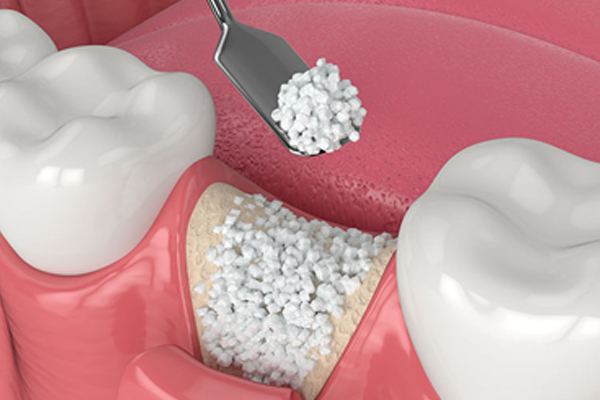Working Time
- Mon-Sat 09:00 – 19:00
Sunday Closed
Contact Info
-
Phone: +90 533 040 7207
Ask the Experts
Bone Graft

A dental bone graft is a procedure performed when there is bone loss in the jaw. It involves adding bone or bone-like material to the affected area to promote bone regeneration and restore the necessary bone structure.
Dental bone grafts are commonly performed in preparation for dental implant placement. When a tooth is lost or extracted, the surrounding bone may begin to resorb or deteriorate over time. In such cases, a bone graft is necessary to build up the bone volume and density, providing a solid foundation for the dental implant.
Bone grafts can also be performed when bone loss is negatively affecting neighboring teeth. For example, if there is significant bone loss due to periodontal disease, it can lead to the loosening or shifting of adjacent teeth. A bone graft can help stabilize the remaining teeth and prevent further complications.
During a dental bone graft procedure, bone grafting material is placed in the affected area, either from your own bone (autograft), donor bone (allograft), or synthetic materials (alloplast). Over time, the graft material stimulates new bone growth and integrates with the existing bone, creating a stronger and more stable foundation.
The success of a dental bone graft depends on various factors, including the quality and quantity of the existing bone, the type of graft material used, and the patient’s overall oral health. Your dentist or oral surgeon will evaluate your specific situation and determine the most appropriate bone grafting technique for your needs.
Following a dental bone graft, proper post-operative care and regular follow-up visits are essential for successful healing and integration of the graft. Your dental provider will provide you with specific instructions for aftercare and monitor your progress throughout the healing process.
Overall, dental bone grafts play a crucial role in restoring bone structure and supporting dental implants or preserving neighboring teeth. They help ensure the long-term success of dental treatments and improve oral health.
How does dental bone graft work?
After a dental bone graft is placed, it acts as a scaffold or framework that provides support and space for your body’s natural healing processes to occur. The graft material serves as a foundation for your own bone tissue to grow and regenerate.
The bone graft material used in the procedure provides a structure that encourages the migration and growth of new bone cells. Over time, your body’s natural healing mechanisms will integrate the graft material with your existing bone, leading to the formation of new bone tissue.
In some cases, dental providers may enhance the healing process by combining a dental bone graft with platelet-rich plasma (PRP). PRP is derived from a sample of your own blood and contains a high concentration of platelets, growth factors, and other beneficial components. When applied to the graft site, PRP can help stimulate tissue regeneration, promote healing, and enhance the success of the bone graft procedure.
The use of PRP in conjunction with a dental bone graft is a technique that aims to optimize the healing process and improve the overall outcome of the procedure. Your dental provider will determine if the use of PRP is appropriate for your specific case and discuss the potential benefits with you.
Following a dental bone graft, it is important to follow your dental provider’s post-operative instructions and attend regular follow-up visits to monitor the healing progress. W time and proper care, the bone graft will integrate and support the growth of new bone, restoring the necessary bone structure for dental treatments or preserving neighboring teeth.
How common are dental bone grafts?
Dental bone grafts are indeed a common procedure in dentistry, and they can be performed by various dental professionals, including general dentists, periodontists, and oral surgeons.
General dentists are trained to perform basic dental procedures, including simple bone grafts in certain cases. They may handle minor bone grafting procedures, such as socket preservation after tooth extraction or small ridge augmentation procedures.
Periodontists are dental specialists who specialize in the prevention, diagnosis, and treatment of gum diseases, as well as the placement of dental implants. They have advanced training in periodontal procedures, including more complex bone grafting techniques. Periodontists often perform bone grafts to restore lost bone tissue in preparation for dental implant placement or to treat advanced gum disease.
Oral surgeons are dental specialists who focus on surgical procedures involving the mouth, jaw, and face. They have extensive training in complex surgical procedures, including bone grafting. Oral surgeons commonly perform bone grafts for more extensive cases, such as large ridge augmentations, sinus lifts, or reconstructive procedures.
The choice of the dental professional who performs your dental bone graft will depend on the complexity of the case, the specific treatment needs, and the expertise of the dental provider. Your dentist or oral healthcare team will evaluate your situation and refer you to the appropriate specialist if necessary.
It’s important to consult with your dental provider to determine the best course of action and the most suitable dental professional to perform your dental bone graft based on your individual needs and treatment goals.
Types of bone grafts
There are different types of bone grafts used in dental procedures. Here are the four main types:
- Socket preservation: This type of bone graft is performed immediately after a tooth extraction. It involves placing grafting material into the socket left behind by the extracted tooth. The purpose is to prevent the collapse of the socket and preserve the bone volume for future dental implant placement or other restorative options.
- Ridge augmentation: When teeth have been missing for a while, the supporting jawbone may have experienced bone resorption, resulting in a thinner ridge. Ridge augmentation involves adding bone grafting material to increase the width and volume of the jawbone. This procedure aims to create a stable foundation for dental implants or other restorative treatments.
- Sinus lift: A sinus lift, also known as a sinus augmentation, is performed when the maxillary sinuses, located above the upper back teeth, have dropped down and encroached upon the space where dental implants would be placed. The procedure involves lifting the sinus membrane and placing bone grafting material beneath it to create a solid foundation for future dental implants.
- Periodontal bone graft: In cases of severe gum disease, the infection can cause bone loss around the teeth, leading to tooth mobility. A periodontal bone graft involves placing grafting material around the affected tooth to support the existing bone, reduce tooth mobility, and promote bone regeneration.
The healing time for bone grafts varies depending on the individual and the specific procedure performed. In most cases, the bone graft must fully heal and integrate with the existing bone before dental implant placement. However, in some cases, a bone graft and dental implant may be placed simultaneously, depending on the patient’s unique circumstances.

